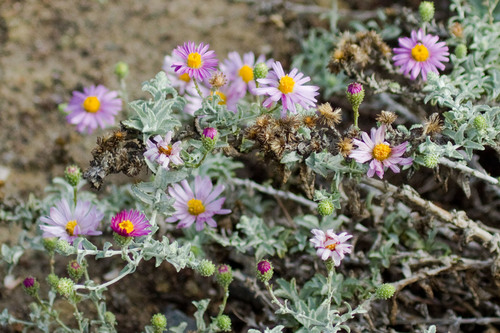California Aster
Search
Wikipedia
| Corethrogyne filaginifolia | |
|---|---|

| |
| Scientific classification | |
| Kingdom: | |
| (unranked): | |
| (unranked): | |
| (unranked): | |
| Order: | |
| Family: | |
| Tribe: | |
| Genus: | |
| Species: |
C. filaginifolia
|
| Binomial name | |
|
Corethrogyne filaginifolia | |
| Synonyms[1] | |
|
Synonymy
| |
Corethrogyne filaginifolia (syn. Lessingia filaginifolia) is a species of flowering plant in the daisy family known by the common names common sandaster and California aster.
The taxonomy of this plant and certain relatives is currently changing; recently the Corethrogynes have been grouped together under the name Lessingia filaginifolia, and then moved back to genus Corethrogyne as a single species with many synonyms.[2]
It is native to western North America from the southwestern corner of Oregon through California to Baja California, where it is a common member of many plant communities, including chaparral and woodlands, forests, scrub, grasslands, and the serpentine soils flora.[3][4]
Description
Corethrogyne filaginifolia is a robust perennial herb or subshrub producing a simple to multibranched stem approaching 1 metre (3.3 ft) in maximum length or height. The densely woolly leaves are several centimeters long and toothed or lobed low on the stem and smaller farther up the stem.[5]
The inflorescence is a single flower head or array of several heads at the tips of stem branches. The head is lined with narrow, pointed, purple-tipped phyllaries which curl back as the head matures. Inside are many purple, lavender, pink, or white ray florets and a center packed with up to 120 tubular yellow disc florets.[5]
The fruit is an achene with a pappus of reddish bristles on top.[5]
References
- ^ The Plant List, Corethrogyne filaginifolia (Hook. & Arn.) Nutt.
- ^ Flora of North America: Corethrogyne
- ^ Biota of North America Program 2014 county distribution map
- ^ Calflora taxon report, University of California, Corethrogyne filaginifolia (Hook. & Arn.) Nutt., common sandaster
- ^ a b c Flora of North America: Corethrogyne filaginifolia
External links
![]() Media related to Corethrogyne filaginifolia at Wikimedia Commons
Media related to Corethrogyne filaginifolia at Wikimedia Commons
- Corethrogyne filaginifolia at Calflora
- Corethrogyne filaginifolia at Jepson eFlora
- United States Department of Agriculture Plants Profile for Corethrogyne filaginifolia (common sandaster)
- Corethrogyne filaginifolia — Calphotos Photo gallery, University of California

